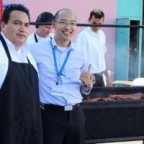I have lived most of my life in Nagoya, Aichi, where I was continuously educated from the age of 7 of the threat of a big magnitude 8 earthquake, called the Nankai megathrust earthquake. It is said to be the combination of 3 huge earthquakes from the Tokai region to the Kyusyu region. I grew up with the fear of my hometown being totally destroyed with my family underneath it, which caused me to lose sleep from time to time because of nightmares of my grandmother being squashed underneath a huge cupboard in her bedroom or seeing myself struggling for my life in the heavy smoke of a burning building.
However, this caution brought through the Japanese education system has been planted in my heart, the yearning for a life of zikyu-zisoku, self-sufficiency: the ability to produce goods and retain skills on your own.
I clearly understood that under disastrous circumstances, you have to take control of your own actions and need living supplies for survival. So, I took all of the evacuation drills seriously, had an emergency bag under my bed, memorized the phone number 1-7-1, and taught my family how to leave a message on the emergency dial. I also eagerly watched a not so serious variety channel called “Ogon-Densetsu” where a comedian lands on a deserted island and hunts and cooks his own meals for three days. I was heavily influenced by that show and often shared with my family my plans and ideas of catching fish or picking edible yomogi plants.
No one took my lectures seriously, but I wasn’t too worried because my mom grew vegetables in the garden attached to our 1st floor apartment. And we used electronic water tanks, which could store up to 20L, so I was sure we had enough food supplies to survive.
My mother was a self-sufficient woman as I recall her in those days. I remember helping her grow a lot of vegetables. In the spring, we harvested cabbages, welsh onions, nanohana (rape blossoms), and katsuo-na. In the summer, it was cucumbers, melons, loofahs, tomatoes, and green peppers. From late summer to the depth of winter, it was corn, parsley, potatoes, radishes, turnips, and Chinese cabbages. We usually planted the seeds a season ahead of the harvest. I learned about the vegetables of the seasons.
I learned how to wash vegetables for fresh salad use; baking soda for pesticide, salt for bug bites and copper water (just put in 10 yen) to kill larvae. Most importantly, I learned the joy and a sense of accomplishment of being self-sufficient while cooking and eating our own products. The pepperoncino using dried parsley was my ultimate favorite homemade meal.
My mother also put time into sewing and tole painting. She often used her sewing machine to make my fashionable clothing from the cloth of my choice. I used to wear reddish-purplish pants with white teddy bears, which were my favorite, and used Hello Kitty or Pokémon lunch bags and napkins at school. They were all cute & stylish. She also made fancy table runners using lace and tassels for special occasions like Christmas or Halloween, or made dust cloth out of old bath towels. I think it was half about hobby and half about saving money. Her most energetic hobby was tole painting, where you paint and decorate interiors, signs or utensils made out of wood and steel. She created beautiful signs for each of the rooms.
When I was 12 years old, we moved out of the apartment and started living in a newly built house right across the main street but in a new neighborhood. This was due to my parents’ business expansion and the arrival of new family members: my two little sisters. Things around the house became suddenly hectic, and our self-sufficient activities started to decline. By the time we’ve completed our move in 2002, my mother was hardly cooking, cleaning or putting time in her hobbies anymore. She started outsourcing her homely chores to a woman called Moriyama-san, a super-shufu (housewife) in her 50’s. It has been more than 10 years since we welcomed her into our family and her cooking became my family’s taste of home.
However, a realization hit me 2 years ago, when I started living alone in Tokyo. My mother called me one summer day to ask where she could find the tomato cans for soup. Moriyama-san caught a summer fever and was sick in bed. I remember the cold feeling in my heart despite the hot weather of early August. After telling her that it was in the left cupboard above the counter, I suddenly had the urge to ask how to make that parsley pasta. When she told me she didn’t remember, I realized that my mother no longer had the ability of self-sufficiency that she used to have, and many of her original recipes were gone. She can’t make her way around the kitchen anymore, so how can she remember her way around the garden?
I know that Japan is a great country when dealing with earthquakes and has many supplies to help people sustain their livelihood. However, relying completely on outside help means that your livelihood is decided for you by outside forces and circumstances. If the road shuts down and the supplies won’t reach you until half a day later, it means that you’ll have to wait half a day to eat, or to tidy yourself up with clean clothing. Self-sufficiency creates a choice under those circumstances. If you produce or take care of your own food, you won’t have to wait and starve. Most importantly, you’ll have the mindset to try to do things on your own; to take control of your own life.
Yukari Lewis Ishizuka graduated from the Department of English Studies in 2018. This essay originally appeared in the 3rd issue of Angles, the student journal of new writing.


















